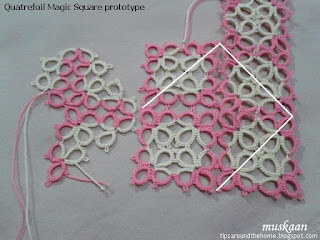quatrefoil
hexagon – lie of the land
I mentioned how the quatrefoil hexagon was giving me
trouble. My very first attempt ruffled, but settled down after the rolling pin
blocking method. Not satisfied, many tweaks were sporadically attempted....
an
uneven surface !
Here is the condensed result of my ‘logical’ rationale of
changing the joining point, the inner diameter, the outer cross section, etc. –
1. original – lays flat after blocking
2. long inner rings – I like the effect, but overlaps
around the edge
3. works perfectly as a pentagon
4, 5, 6 – discarded midways.
There was one more which turned into a nice square, but
has run away somewhere – it had a small SR between each quatrefoil.
This scrapyard does not include all the tiny scraps I threw away immediately ;-D
a
volunteer to clean up ?
As the name suggests, it is a quatrefoil pattern – 4 equal-size
rings; hence I cannot change the stitch count on any of the 4 main rings.
Can any of you experienced designers/tatters offer some
tips on how to get it flatter, without compulsory blocking?
Or perhaps someone could offer to test tat this medallion (only left one above) to
decide whether the ruffle is negligible or workable or whether the pattern
needs to be scrapped ?
I would very much appreciate a volunteer to test tat it.
charmed
perhaps
Meanwhile I went ahead and completed the bookmark. It is
made in one pass, using quatrefoil squares, and hexagon for the main body and a
pentagon for the charm, all connected with lock chains.
This is just the prototype, with a few distracted errors
(one cannot watch a tennis match and create a pattern simultaneously !) Once the hexagon issue is resolved, I will re-tat and write up this bookmark pattern.
squared
paths
While writing my previous post I had identified a simple path to create a magic square
out of the quatrefoil square. It involves tatting the entire square and
climbing out with a SR. This is possible because there are no chains in the
pattern.
But Robin’s tutorial post rekindled my curiosity and I wondered how
the triangulation would work on this all-rings pattern. Well, it works fine
obviously (the left one in pic). So this pattern actually has 2 paths to choose from.
I have worked further since this pic was taken & it
reminded me suddenly of the Fandango motif (round 1 only). Quickly checked it
out – phew, not the same.
It will be interesting to see how the 2 colours work out since some of the corner rings are split.
I believe that this rings-only magic square might perhaps
be easier to work as a first-time serpentine magic square because one does not
have to reverse work between rings and chains.
All tatting done in size 40 thread.
Please leave a comment (or email me) if you wish to test tat the hexagon.
I also have a question about writing/presenting the pattern.
Grateful for any help you can provide.
tatting scraps make the best scrapyard
!!!!
Related Posts :






Beautiful bookmark, and a great start to your magic square!
ReplyDeleteAs for the quatrefoil hexagon, you can reduce the circumference by joining those three outer rings a stitch or two higher. This will draw everything upward and help the pattern to lay more flat. It's difficult to explain in a comment alone, so I will send you an email with a tatted sample and stitch counts.
Your sampler worked perfectly, Robin ! Thanks for tatting it up so quickly :-)
DeleteBeautiful bookmark :) I can to test tat the hexagon:)
ReplyDeleteOh, dear! You and Robin are talking in terms that barely make sense to me. I guess I should have paid more attention in math class!
ReplyDeleteVery Pretty bookmark!! Would love to test tat hexagon Muskaan.
ReplyDeleteI am with Diane maths was not my strong point, but I think I get the idea.
ReplyDeleteThanks Anetta & Usha :-))))
ReplyDeleteYou do know that we deliberately use terms to confuse you, Diane ;-D Actually Margaret there is no real maths here. It's merely a matter of putting 4 triangles together to create a square. And if these squares are placed adjacent to each other to create a larger square , then we can tat the triangles in a continuous way to fill in the spaces.
Have I confused you further - that is my intention ;-D
Have a great day everybody, while my dear testers get busy with their testing
Love your bookmark!!! :)
ReplyDeleteI too am not really understanding the processes, but I love learning and watching and maybe some day I will get it. It usually takes me longer!! :)
Thanks, Sue :-) I had a tough time when I made my first magic square couple of years back, but it is an interesting concept and I enjoy the challenge :-) I really do think that using these rings-only pattern will be a good starting point. Wait for the pattern ;-D
Delete